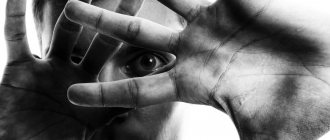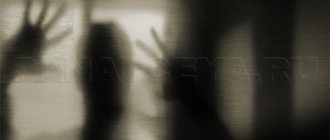Schizoaffective disorder (schizoaffective psychosis) is a condition that simultaneously combines the psychotic symptoms of schizophrenia (delusions, hallucinations) and signs of a mood disorder (depressive and manic).
This pathology is an intermediate link between schizophrenia and bipolar disorder. Due to the combination of elements of different mental illnesses, making a diagnosis presents difficulties that only a specialist with extensive experience can handle. At the same time, it is important to recognize the disease as early as possible - the longer no help is provided, the higher the risk of a protracted, poorly controlled course and worsening of symptoms.
Schizoaffective disorder is an intermediate condition between schizophrenia and bipolar affective disorder.
The set of symptoms is called affective-paranoid syndrome. This concept includes two types of manifestations of the disease:
- Depressive-paranoid syndrome is a low mood with hallucinations and delusions of a negative, self-blaming nature.
- Manic-paranoid syndrome is an elevated mood with hallucinations and delusions of a praising nature.
There may be ideas of persecution or influence from ill-wishers, otherworldly forces, alien creatures.
All this leads to severe social dysfunction, contributes to the emergence of suicidal thoughts and intentions, and significantly increases the path to healing. With timely treatment, the disease is successfully controlled, and patients return to normal life and work.
Factors that increase the risk of developing schizoaffective psychosis:
- genetic - having a close relative with schizophrenia, schizoaffective disorder or mood disorder;
- drug use (LSD, cocaine, opiates);
- stressful situations.
There are manic, mixed and depressive types of disorder, each of which is characterized by its own unique symptoms.
Schizoaffective disorder manic type
This variant is characterized by an abrupt onset and vivid symptoms. Schizophrenic symptoms are combined with manic manifestations. Mania in schizophrenia is characterized by sharply elevated mood, delusional ideas of grandeur or persecution, motor agitation, and lack of social inhibition. There is a pathology of desires (increased sexual activity, appetite), aggression is possible.
Manic syndrome is a pathologically elevated mood with agitation. A person grabs hold of everything, gives away property, and can spend many years of savings at once.
In manic schizophrenia, the symptoms of a mood disorder are expressed by the following main manifestations:
- accelerated thinking, distracted attention, slipping from topic, incoherent speech;
- hyperactivity, decreased need for rest and sleep;
- a sharp increase in mood that does not go away even in situations in which this would be expected.
To make a diagnosis, schizophrenic symptoms must also be present: auditory and visual hallucinations, delusions of various contents. This includes delusions of physical influence: a person’s belief in the influence of certain physical forces on him - an electric field, witchcraft, radiation. A frequent variant is delusion of attitude: he perceives all neutral events and remarks not related to the patient as having a negative meaning for him.
Important
If you suspect signs of a mental disorder in yourself or a loved one, you should immediately contact a specialist. Further uncontrolled development of symptoms leads to a worsening of the condition, the emergence of a difficult situation in the family and poses a danger to children and the environment.
It is worth noting the increased risk of developing manic schizophrenia in women in the postpartum period. Hormonal changes, psychological and physical stress are the trigger for the development of the disorder.
Treatment of schizoaffective psychosis
Schizoaffective psychosis is treated with medication. The choice of medications directly depends on the severity of the disease. In most cases, the choice is made in favor of antipsychotropic drugs that suppress the symptoms of psychosis, and antidepressants if there is a sharp change in mood. The help of a psychiatrist is also required to study the disease and increase the effectiveness of treatment. In addition, the patient’s relatives may also need psychological help.
In most mild cases, outpatient treatment is sufficient for patients. Hospitalization is required only in rare cases when there is a threat to life, or when symptoms of the disease worsen. It is important to understand that, like the vast majority of diseases of this type, it is not completely curable. But with the help of competent treatment, it is possible to achieve long-term remission and enable a person to lead a normal lifestyle.
Where can they help?
The private clinic "ROSA" specializes in the treatment of psychological and neurological diseases, including schizoaffective psychosis. The clinic staff consists of highly qualified experienced doctors and junior medical staff. Over the years of its existence, the ROSA clinic has treated thousands of patients with various diagnoses and received high-quality medical care that improves their quality of life. If necessary, contacting the clinic can be completely confidential.
During the consultation, which is held in the clinic, at your home or online, the doctor will clarify your medical history, ask about complaints and decide on further actions. Treatment can be carried out at home or in a comfortable hospital operating around the clock.
Schizoaffective disorder depressive type
This option combines schizophrenic symptoms with depressive symptoms. The patient is lethargic, inhibited, and experiences feelings of emptiness, sadness and a sense of worthlessness. To this are added hallucinations and delusions typical of schizophrenia.
Main manifestations of depression:
- depression, melancholy;
- loss of interest in life and previous activities;
- fatigue, decreased energy potential, sleep disturbances;
- feelings of guilt and uselessness;
- memory and concentration problems.
The picture of a characteristic depressive-paranoid syndrome includes delusions of various topics. Blaming delusions - a person is convinced that others consider him guilty of committing shameful acts or crimes. With delusions of harm, the patient is sure that they intend to harm him, to rob him. A common variant is delusions of persecution, when a person believes that he is being spied on by military organizations or pursued by witchcraft forces. All this happens against the background of pronounced depressive symptoms.
Important
Depressive syndrome cannot be ignored by a specialist: in the best case, a person stops working, leaving the house, taking care of himself, in the worst case, he may commit suicide.
With this type, the episodes are not as vivid as with manic, but they cannot be ignored. Diagnosis and treatment of schizoaffective disorder of the depressive type must begin as early as possible, because without the intervention of a specialist, this condition tends to last a long time and often leads to suicidal actions.
How does bipolar disorder manifest?
The difficulty in diagnosing the problem lies in the fact that it is characterized by symptoms of both schizophrenia and affective disorder. It all starts, as a rule, with auditory hallucinations. A person may hear distant voices and believe that everyone around him is commenting on his actions. In a neglected state, the patient thinks that those around him read his thoughts. This causes attacks of panic and fear.
The disorder continues with the manifestation of symptoms such as the patient suddenly freezing in one position, delirium and loss of the semantic component of his speech.
In addition, schizoaffective disorder occurs with the presence of symptoms characteristic of affective mental disorders. For example, the need for sleep gradually decreases, the speed of word reproduction increases, grandiose plans begin to arise and delusions of grandeur develop.
Such mixed symptoms greatly overload the nervous system. If nothing is done, there is a high risk for the patient to lose awareness and adequacy.
Definition of the concept
The division of endogenous psychoses, which was carried out by E. Kraepelin (1893), into dementia praecox (called schizophresophrenia by E. Bleuler) and manic-depressive psychosis did not leave room for mental illnesses occupying an intermediate position. What similar diseases have in common with manic-depressive psychosis is the presence of long-term affective states, very similar to its phases, and light intervals with complete or almost complete mental health. However, in schizoaffective psychosis, during depressive and manic states, symptoms appear that are not characteristic of manic-depressive psychosis: delusions of persecution, relationships, poisoning, abuse, auditory and olfactory hallucinations, phenomena of mental automatism, etc. As the phases are repeated in the interictal period, they may persistent personality changes occur in the form of increasing inactivity and apathy, poverty of emotional manifestations, isolation and little sociability. These signs distinguish such cases from manic-depressive psychosis and bring them closer to schizophrenia.
Such cases began to be designated as “third psychosis”, “mixed psychosis”, “intermediate psychosis”, “cycloid psychosis”, etc. Those authors who saw an alternation of phases in manic-depressive psychosis and considered this property specific to this disease, and The duration of their observations was limited, as a rule, to two or three attacks, and such cases were interpreted as “atypical manic-depressive psychosis.” For teenagers, this was done by S.S. Mnukhin (1940). On the contrary, those who believed that the phase of the course is a property that is by no means pathognomonic for manic-depressive psychosis, and symptoms such as delusions of the influence of the phenomenon of automatism, olfactory hallucinations were attributed to schizophrenia, tried to trace the fate of these patients for as long as possible and after several attacks, in a number of cases signs of persistent personality changes along the schizophrenic type were found. Proponents of this point of view designated such psychoses as “periodic schizophrenia”, “circular schizophrenia”, “recurrent schizophrenia”, etc. At the same time, along with circular forms, other forms of schizophrenia with a periodic course - without manic or depressive states, and with pictures of oneiric syndrome, periodic catatonia, etc. With regard to adolescents, this point of view was presented in the works of G. E. Sukhareva (1937, 1974) and V. Sh. Vrono (1971).
Finally, there is an assumption that such psychoses constitute a special form of mental illness, differ significantly from both manic-depressive psychosis and progressive schizophrenia, or represent a combination of both diseases at the same time.
In the American psychiatric literature, these mental illnesses have taken root in the rather successful name “schizoaffective psychoses,” which was proposed by J. Kasanin back in 1933. This name was adopted in the International Classification of Diseases (9th revision, 1977) - “schizoaffective type of schizophrenic psychoses.”
From our point of view, for practical purposes at this stage of development of psychiatry it is convenient to classify schizoaffective psychoses as a special group. Unlike progressive schizophrenia, they not only have a phasic course, but also a more favorable prognosis - the possibility of complete social adaptation without special rehabilitation programs remains even after several attacks of the disease. Schizoaffective psychoses also require different treatment compared to progressive schizophrenia - combined maintenance therapy with lithium salts and psychotropic drugs. Unlike manic-depressive psychosis, schizoaffective psychosis has a worse long-term prognosis.
However, within the framework of schizoaffective psychosis it is advisable to include only circular forms with atypical manic and depressive states. It seems that they should not include periodic psychoses, where the pattern of attacks is limited only to syndromes of disorder of consciousness (oneiric, twilight, amentive) or catatonic stupor.
Features of the clinical picture
Atypical in schizoaffective psychosis in adolescents are, as a rule, both manic and depressive phases.
Manic states. These phases most often occur in the form of paranoid mania (see Chapter IV). Elevated mood is manifested not so much in excessive cheerfulness, but in a kind of nervousness and excitement. Instead of liveliness of communication, importunity appears. Talkativeness turns into reasoning. You often feel a subjectively painful influx of thoughts in your head.
Delusions of grandeur, psychologically understandable in a manic state, tend to acquire a grotesque and even absurd character. The teenager “discovers” unprecedented abilities: predicting the future, the weather, “seeing through everyone,” using his willpower to force others to act, instilling his thoughts in them, discovering the “formula of happiness,” etc., he himself can feel like a hypnotist. Increased well-being can also be refracted into ridiculous delusional ideas of greatness - a teenager declares that in a matter of days he has grown several centimeters, his muscles have gained strength, his penis has enlarged, etc.
However, delirium that does not correspond to the elevated mood is even more striking. Ideas of persecution are expressed (conspiracies, gangs, bandits, spies are going to beat, kill, deal with relatives), ideas of attitude (“everyone on the street is looking at me”), exposure to hypnosis, electric shock, rays, ideas of cruel treatment (they are going to castrate, disfigure the face , gouge out eyes).
Delirium is often combined with auditory and sometimes olfactory hallucinations. Voices “threaten”, “call names”. They begin to sniff the food carefully. Pseudohallucinations and phenomena of mental automatism may occur - spontaneous statements on this topic are infrequent, but upon questioning these experiences are often confirmed. The surrounding environment may be perceived as somehow strange, unusual, as if everyone had changed clothes especially for the patient and were performing some kind of performance (nonsense of staging).
With angry mania, there is motiveless, unprovoked anger, and there may be outbursts of brutal aggression towards others.
Unlike typical manias, appetite is not always increased; even food refusals may occur. Sleep is always bad. Sexual desire is not only increased, but behavior is characterized by a loss of a sense of shame - they expose themselves in front of strangers, openly masturbate, and do not hesitate to reveal homosexual inclinations.
phenomena of hospitalism – previous | next – oneiric experiences
Adolescent psychiatry. Content.











